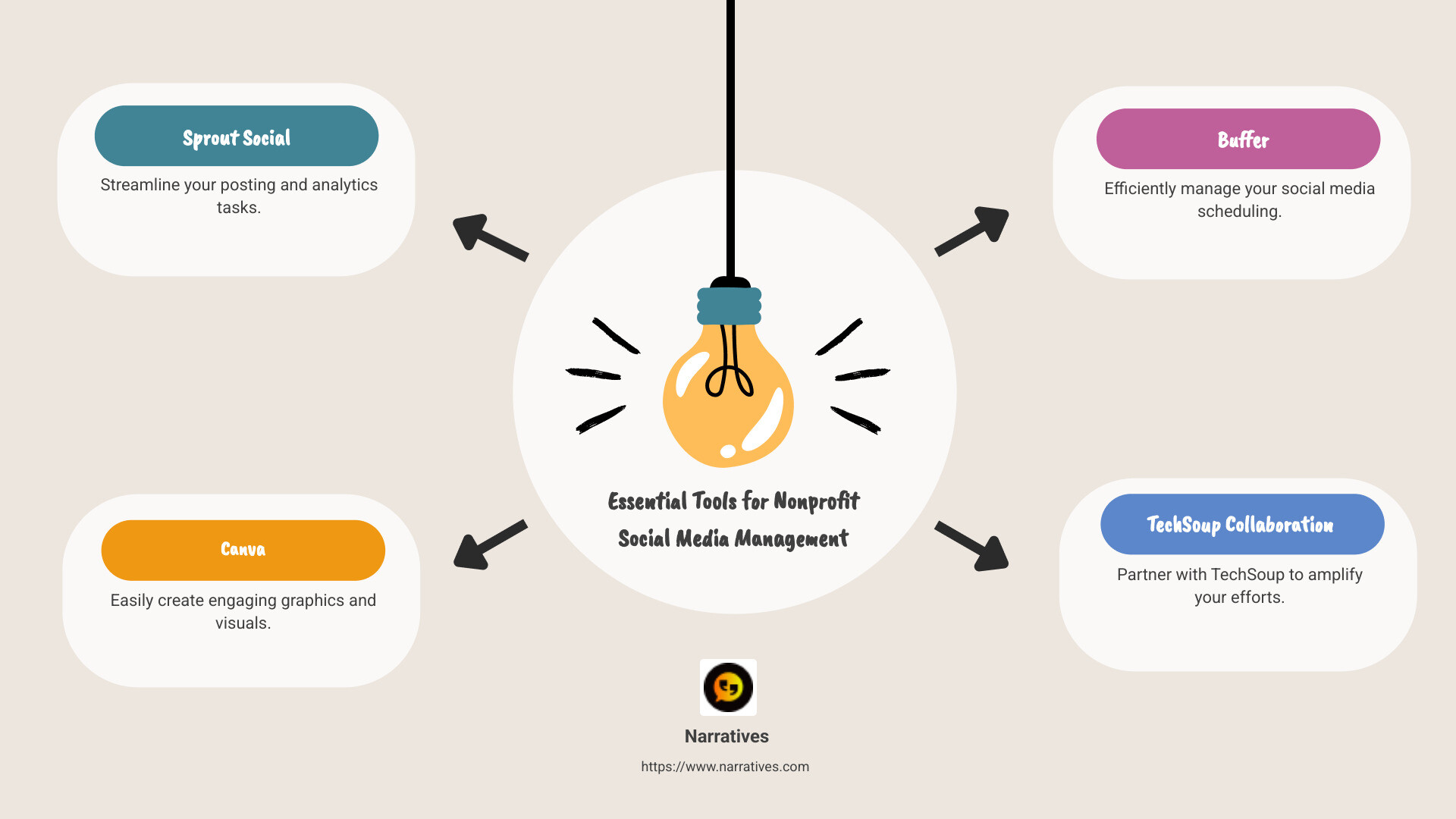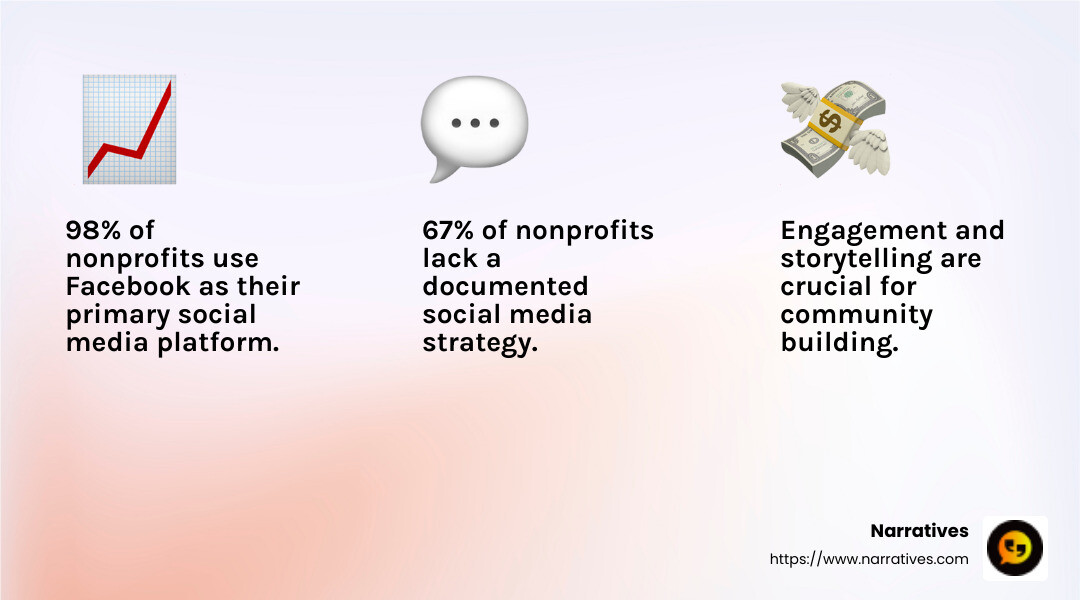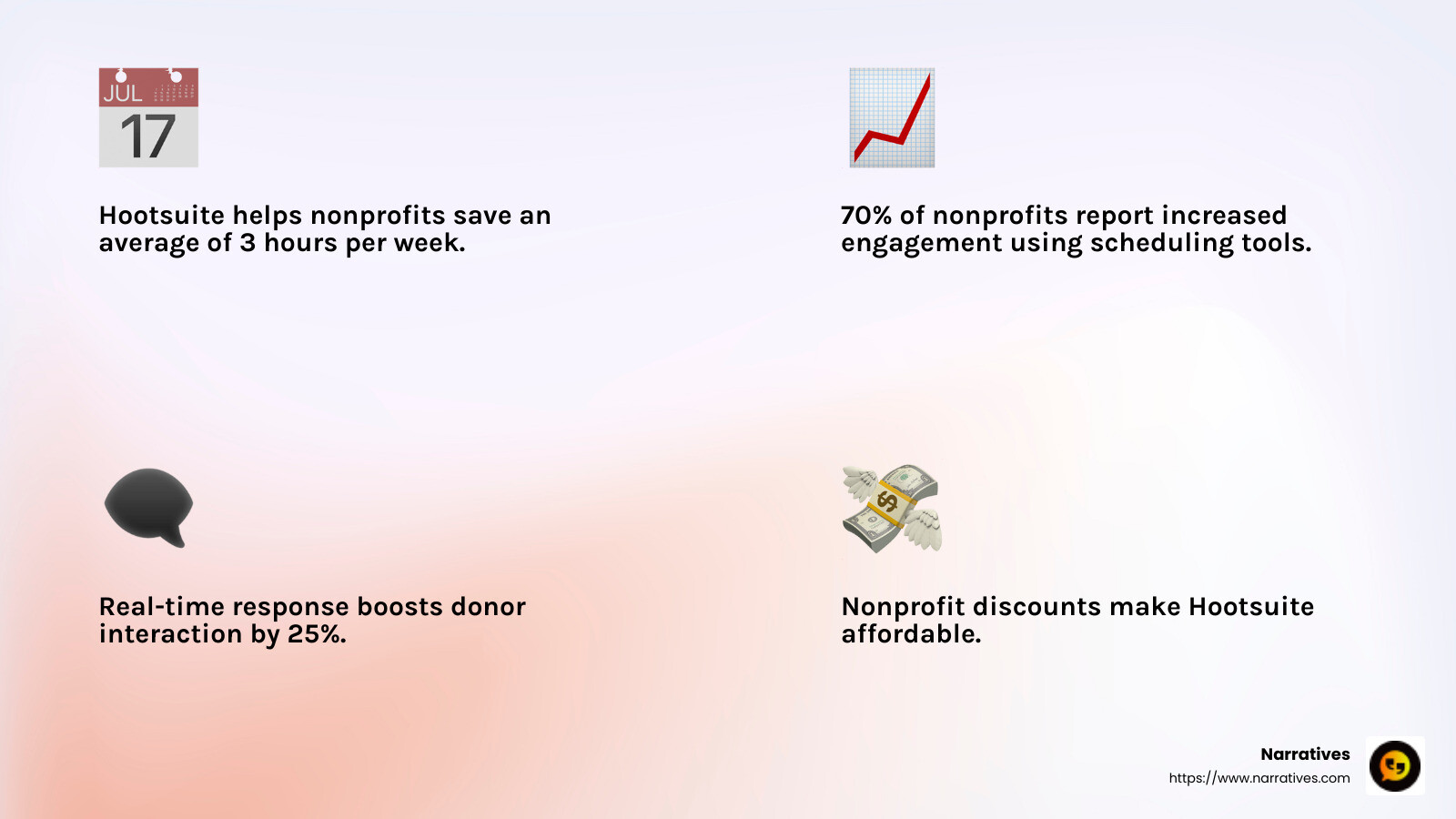Social Media Management for Nonprofits: Tools to Make a Difference

Social media management for nonprofits can be the game changer in telling your organization's story. Not only does it help amplify your mission, but it also connects you with a broader community eager to support your cause. For a quick start, here are the essentials you need to know:
- Choose the right tools: Sprout Social, Hootsuite, and Buffer can streamline your posting and analytics tasks.
- Improve your visuals: Use Canva for easy graphic creation.
- Engage your audience: Regular posts and interaction boost your presence.
In the digital world, it's crucial for nonprofits to accept social media to spread their message effectively and emotionally. Nonprofits, much like major brands, need to employ strategic storytelling to engage their audience. McKinsey’s insights highlight the importance of stories like "Who am I?" and "Vision" to captivate and grow your following.
Moreover, allocating some budget for ads or boosted posts is necessary. Despite the notion that social media is "free," effective campaigns often require investment so that your content reaches beyond your immediate circle.
Collaborate with partners like TechSoup and leverage tools and platforms that amplify your efforts.

Relevant articles related to social media management for nonprofits:
- social media management strategy
- social media marketing for non profit organization
- social media content management companies
Importance of Social Media for Nonprofits
Social media is not just a tool for connecting with friends; it's a powerful platform for nonprofits to raise awareness, build a community, and drive donations. Let's explore why these aspects are crucial for any nonprofit organization.
Raising Awareness
Social media allows nonprofits to reach a larger audience than traditional methods. With billions of users on platforms like Facebook and Instagram, your message can go far beyond your local community. According to a HubSpot survey, 98% of nonprofits are already using Facebook as their primary social media focus, highlighting its importance in spreading awareness.
Storytelling is key. Share real stories that showcase the impact of your work. For example, a nonprofit supporting education can share stories of students who have benefited from their programs.
Visual content grabs attention. Use tools like Canva to create eye-catching graphics and videos that tell your story in a compelling way.
Building a Community
A strong online community can be a nonprofit's greatest asset. Social media platforms allow you to engage with supporters, volunteers, and beneficiaries in real-time. This engagement fosters a sense of belonging and loyalty among your followers.
Engage regularly: Respond to comments, share updates, and ask for opinions. This interaction builds trust and makes your community feel valued.
Create groups or forums: Platforms like Facebook offer the ability to create groups where members can discuss, share experiences, and support each other.
Driving Donations
Social media is a powerful tool for fundraising. With the right strategy, you can convert followers into donors.
Call-to-action: Every post should have a clear call-to-action, whether it's to donate, volunteer, or share your message.
Leverage special events: Tie your campaigns to events or specific days, like Giving Tuesday, to boost donations.
Use analytics: Tools like Hootsuite and Buzzsumo can help track which posts drive the most engagement and donations, allowing you to refine your strategy for maximum impact.

In summary, social media is an invaluable resource for nonprofits. By effectively utilizing it to raise awareness, build community, and drive donations, nonprofits can significantly amplify their impact and reach their goals.
Essential Tools for Social Media Management
Managing social media for nonprofits can be daunting. But with the right tools, it becomes much more manageable and effective. Here are some essential tools that can make a real difference in your social media strategy.
Hootsuite
Hootsuite is a game-changer for nonprofits juggling multiple social media accounts. It allows you to schedule posts, track engagement, and manage all your accounts from one dashboard. This saves time and ensures consistency across platforms. Plus, with nonprofit discounts, Hootsuite becomes even more accessible.
Benefits:
- Schedule posts in advance.
- Monitor social trends and conversations.
- Respond to comments and mentions in real-time.

Canva
Creating visually appealing content is crucial for engagement. Canva is perfect for designing social media graphics without needing a design background. With its easy-to-use templates, nonprofits can quickly produce professional-looking visuals for Facebook, Instagram, and more.
Benefits:
- Access to over 100 million stock photos and templates.
- Free Canva Pro accounts available for nonprofits.
Buzzsumo
Buzzsumo takes the guesswork out of content creation by helping you find popular keywords and hashtags. This tool is vital for boosting your posts' visibility and engagement. It also offers insights into your SEO performance by tracking shares and mentions.
Benefits:
- Monitor popular trends and topics.
- Analyze content performance and backlinks.
Planable
Planable is all about collaboration. It allows teams to plan, review, and approve social media content in one place. This ensures that everyone is on the same page and that your posts align with your organization's goals.
Benefits:
- Simplifies content approval workflows.
- Offers a visual content calendar.
Later
Later is a scheduling tool that focuses on visual platforms like Instagram and Pinterest. It's excellent for planning and scheduling posts, including Stories. Later also provides analytics to help you understand your audience better.
Benefits:
- Schedule posts for various platforms.
- Analyze engagement metrics to refine strategies.
Grammarly
Writing clear and error-free content is crucial for maintaining professionalism. Grammarly helps ensure your social media posts are grammatically correct and concise, enhancing your organization's credibility.
Benefits:
- Real-time grammar and spelling checks.
- Suggestions for improving clarity and tone.
Sprout Social
Sprout Social combines social media management with powerful analytics. It helps track engagement, analyze performance, and manage customer interactions efficiently. For nonprofits, understanding what content resonates with your audience is invaluable.
Benefits:
- Comprehensive analytics and reporting.
- Tools for audience engagement and interaction.
These tools can significantly improve your social media management for nonprofits, allowing your organization to focus on what truly matters: making a difference. By leveraging these resources, nonprofits can improve their outreach, engage more effectively with their audience, and ultimately drive more support for their causes.
Social Media Management for Nonprofits: Strategies and Best Practices
Social media management for nonprofits is not just about posting content; it's about creating meaningful connections and driving action. Let's explore some strategies and best practices to help your nonprofit succeed.
Engagement
Engagement is key. It's not just about likes and shares; it's about building relationships. Encourage your followers to comment and share their thoughts. Respond promptly to questions and comments. This interaction builds trust and loyalty.
"When we started responding to every comment, our engagement skyrocketed," shares a nonprofit social media manager.
Algorithms
Understanding algorithms is crucial. Social media platforms prioritize content that sparks interactions. To increase your visibility, post content that encourages engagement. Use questions, polls, and calls to action.
ROI
Measuring ROI (Return on Investment) can be tricky, but it's essential. Track metrics like engagement rates, follower growth, and website traffic. Tools like Hootsuite and Sprout Social offer analytics to help you understand what works.
Fundraising
Social media is a powerful tool for fundraising. Share compelling stories and visuals that resonate with your audience. Use platforms like Facebook and Instagram, which are effective for reaching potential donors.
Consider campaigns that combine storytelling with a clear call to action. For example, a video showing the impact of donations can inspire more support.
By focusing on engagement, understanding algorithms, measuring ROI, and leveraging social media for fundraising, nonprofits can improve their online presence and make a more significant impact.
Measuring Success and ROI in Social Media Campaigns
When it comes to social media management for nonprofits, measuring success is crucial. It helps you understand what's working and where you need to adjust. Here are some key metrics and tools to consider:
Key Metrics
Engagement Metrics: These include likes, shares, comments, and retweets. They show how your audience is interacting with your content. High engagement often indicates that your content resonates with your audience.
Reach and Impressions: Reach is the number of unique users who see your content, while impressions are the total times your content is displayed. Both metrics help gauge your content's visibility.
Traffic Sources: Understanding where your website visitors come from can be enlightening. Use tools like Google Analytics to see if social media is driving traffic to your site.
Conversion Rates: Track actions like newsletter signups or donations that occur after someone engages with your social media. This metric directly ties your social efforts to tangible outcomes.
Analytics Tools
Facebook Analytics and Insights: These tools provide detailed information about your audience and content performance. They can help you tailor your strategy to engage more effectively with your followers.
Hootsuite and Sprout Social: These platforms offer comprehensive analytics features. They allow you to track engagement, follower growth, and more, providing a clear picture of your social media ROI.
Gaining Insights
Analyzing these metrics helps you gain insights into your audience's preferences. For example, if posts with videos consistently receive more engagement, consider incorporating more video content.
"Using analytics, we found that our audience prefers short, impactful stories. This insight helped us refine our content strategy," explains a nonprofit marketing director.
By regularly reviewing and analyzing your metrics, you can make informed decisions that improve your social media strategy and maximize your nonprofit's impact.
Frequently Asked Questions about Social Media Management for Nonprofits
How can nonprofits increase social media engagement?
Increasing engagement on social media is key for nonprofits to amplify their mission. Engagement includes likes, shares, and comments. Here's how you can boost it:
Understand Algorithms: Social media platforms like Facebook and Instagram use algorithms to decide what content appears in users' feeds. To increase visibility, focus on creating content that encourages interaction. This might include asking questions, creating polls, or sharing compelling stories.
Regular Posting: Consistency is crucial. Use tools like Hootsuite to schedule posts and ensure a steady flow of content.
Visual Content: Posts with images or videos tend to get more engagement. Canva can help you create stunning visuals easily.
Community Interaction: Respond to comments and messages promptly. This shows your audience that you value their input and fosters a sense of community.
Boosting Posts: Sometimes, you need to pay for more reach. Boosting posts can help your content reach a larger audience beyond your immediate followers.
What are the best platforms for nonprofit fundraising?
When it comes to fundraising, choosing the right platform is crucial.
Facebook: With its vast user base, Facebook is a powerful tool for fundraising. It offers features like the "Donate" button and fundraising events, making it easy for followers to contribute.
Instagram: While Instagram is more visual, it also supports fundraising through Stories and posts. Use engaging visuals and clear calls to action to encourage donations.
Both platforms allow you to tap into their large audiences and offer integrated tools to facilitate donations.
How do nonprofits measure social media ROI?
Measuring ROI for social media efforts helps nonprofits understand the impact of their activities. Here’s how:
Set Clear Goals: Before you start, define what success looks like. This could be increasing followers, boosting engagement, or driving donations.
Use Analytics Tools: Platforms like Facebook Insights and Hootsuite provide detailed analytics. These tools help track engagement, reach, and conversion rates.
Monitor Metrics: Focus on key metrics such as engagement rates, website traffic from social media, and conversion rates. These metrics provide insights into what's working and what needs improvement.
Adjust Strategies: Use the data to refine your strategies. If a particular type of post drives more engagement, consider creating more similar content.
By effectively measuring and analyzing these metrics, nonprofits can make data-driven decisions to improve their social media strategies and maximize their impact.
Conclusion
Social media management for nonprofits is more than just a buzzword—it's a powerful tool for creating meaningful change. At Narratives, we believe in the transformative power of storytelling to lift the voices of those who are often unheard. By crafting emotionally resonant content, we help nonprofits share their impact stories in ways that inspire action and build trust.
Storytelling is at the heart of what we do. It's not just about sharing information; it's about connecting with people on an emotional level. When a nonprofit shares a story of a life changed or a community uplifted, it does more than inform—it moves people to act. This is the essence of social media's potential: to turn passive viewers into active supporters.
The impact of effective social media management is profound. Nonprofits can reach new audiences, foster community, and drive significant support for their causes. By using the right tools and strategies, like those discussed in this article, nonprofits can harness the full potential of social media to make a real difference.
For organizations looking to amplify their impact through digital storytelling, we invite you to explore how Narratives can be your partner in this journey. Let us help you craft stories that resonate and inspire. Find more about our media services and how we can support your mission.
In the end, it's about more than just managing social media—it's about changing the world, one story at a time.


